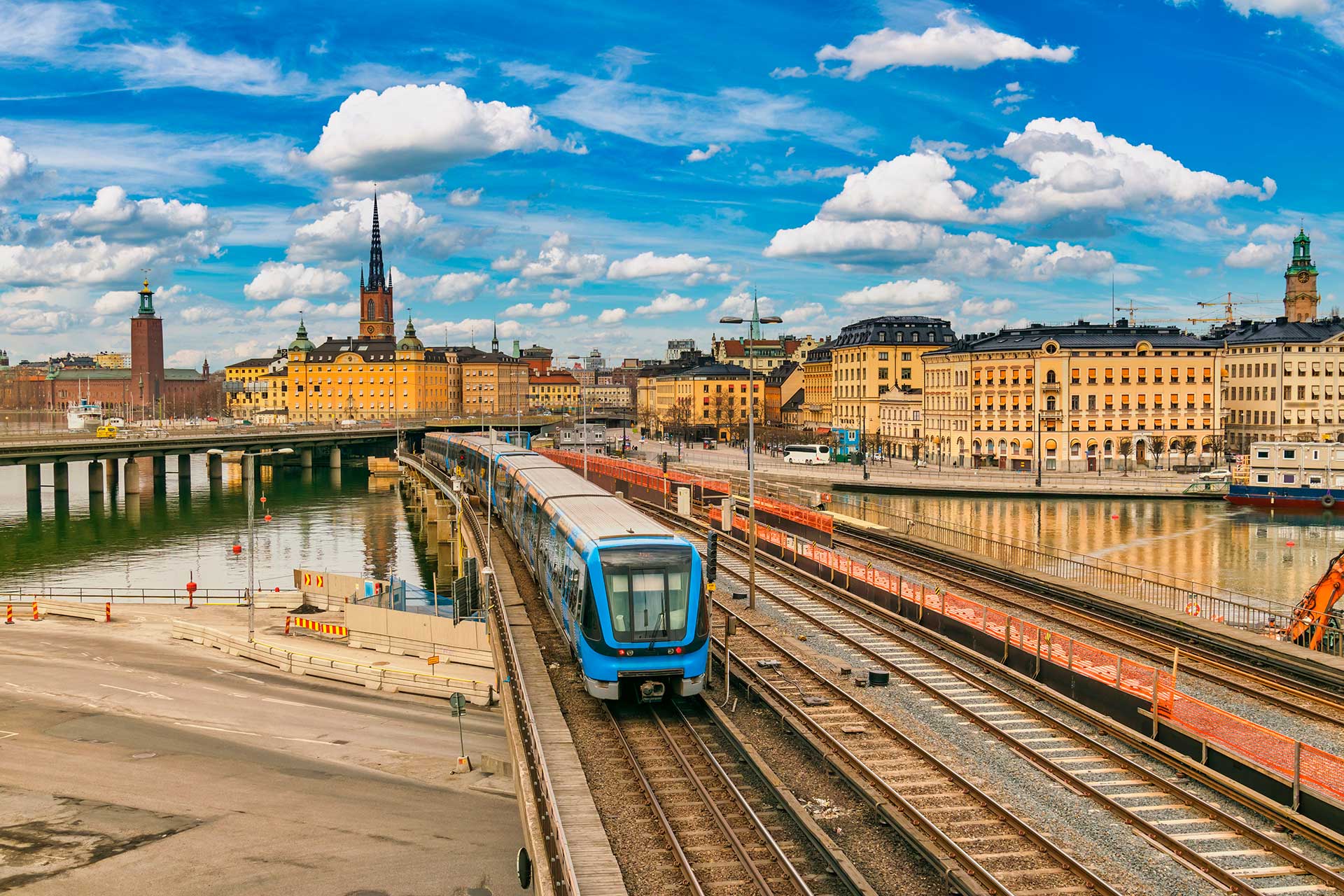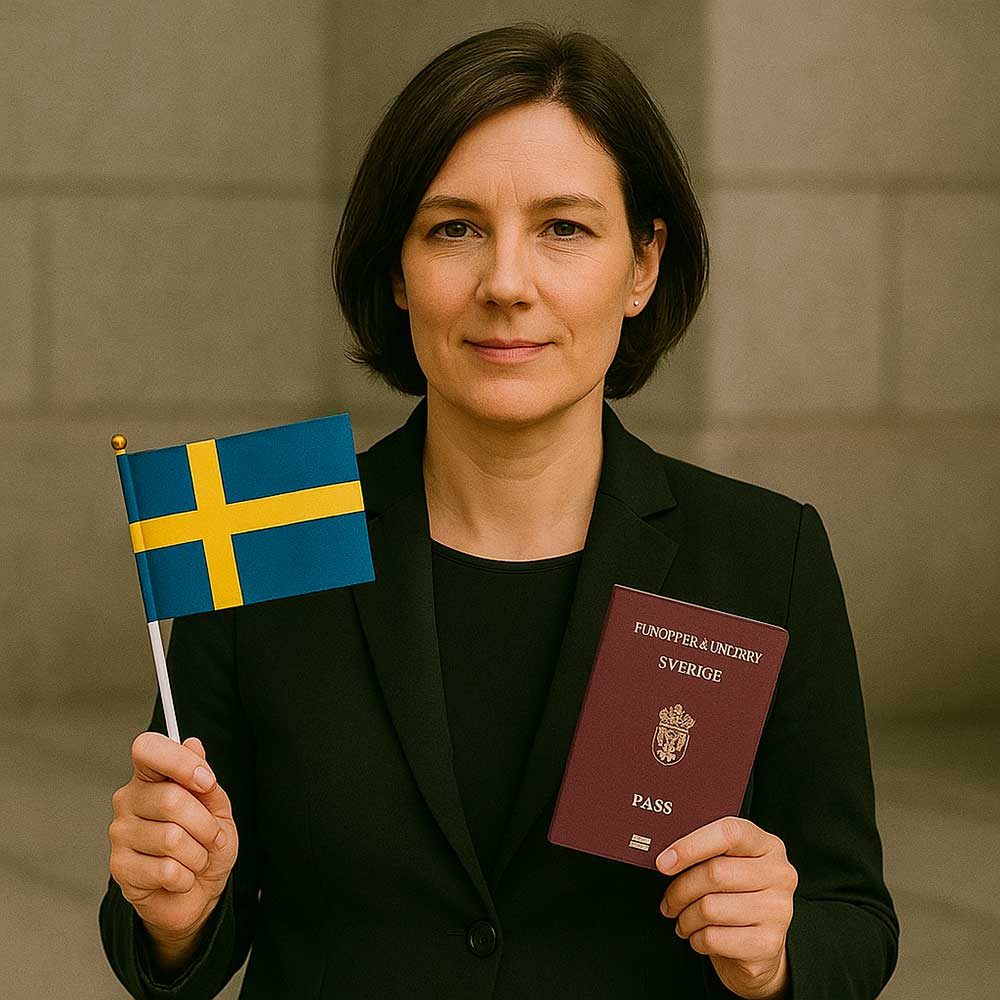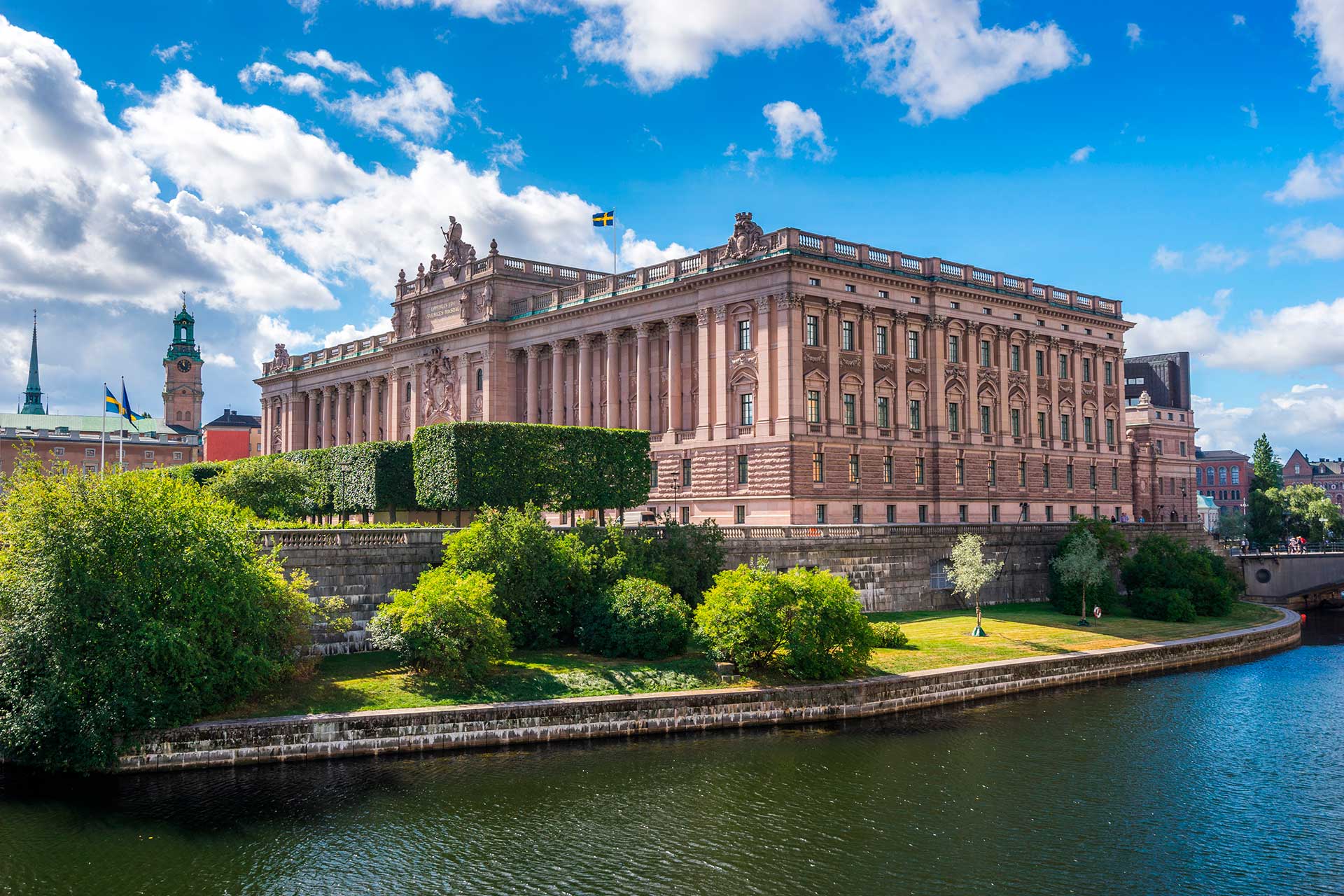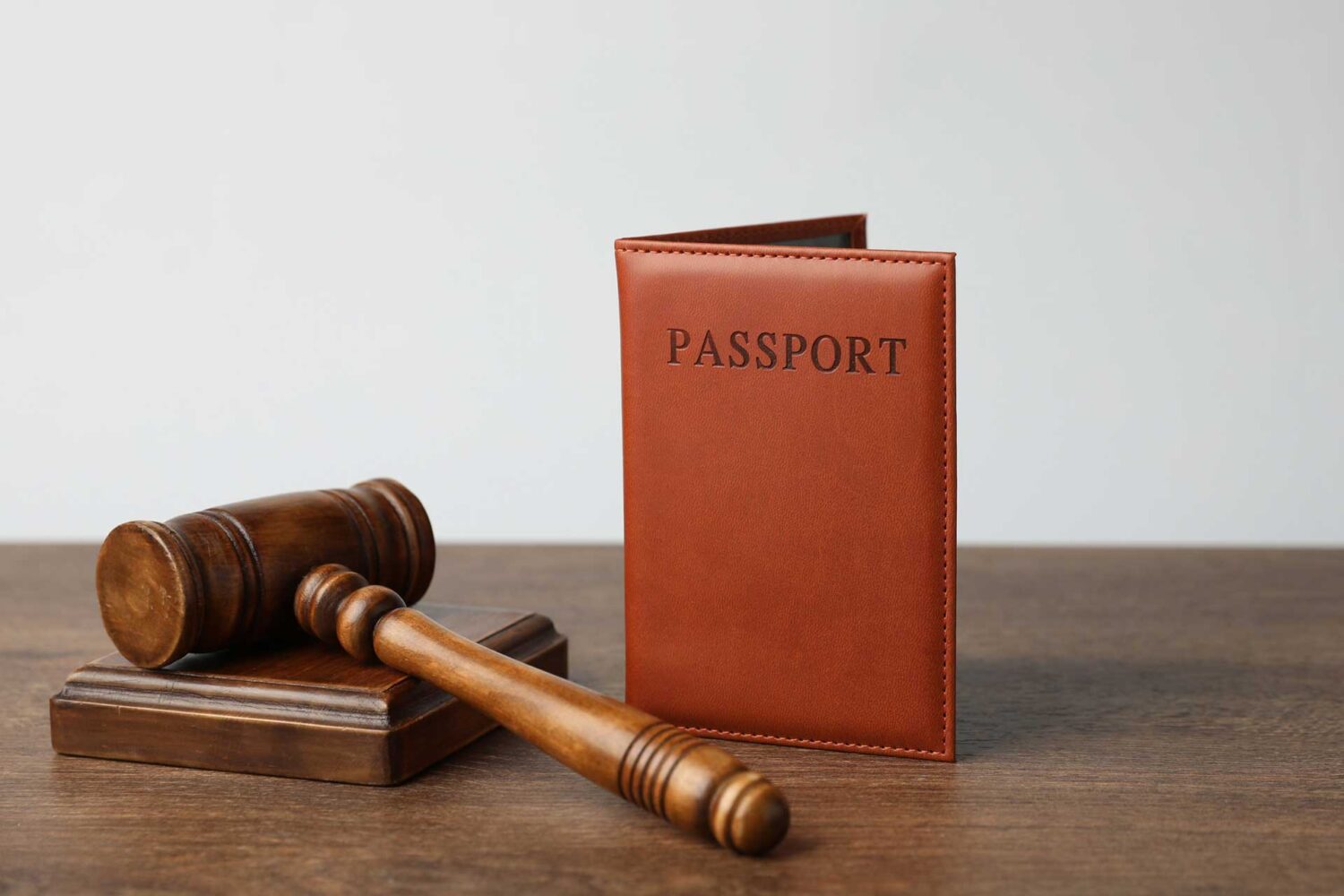Swedish citizenship is a highly sought-after status thanks to the country’s high standard of living and the privileges of being an EU citizen. A Swedish passport grants full rights unavailable to holders of temporary or permanent residence permits (TRP/PRP). Unlike permanent residency, which requires periodic renewal and may be revoked after long absences, citizenship offers a lifetime right to live in the country and travel freely abroad.
Moreover, Swedish citizenship allows you to live and work in any EU country, vote in national elections, and apply for government positions. That’s why entrepreneurs, families with children, students, and other migrants aim to go through the demanding naturalization process to become full citizens of Sweden. Below we detail who qualifies for Swedish citizenship, how to obtain a Swedish passport, and how long the process takes, based on current laws and 2025 practices.
Advantages of Swedish Citizenship
Swedish citizenship offers a wide range of benefits that set it apart from other immigrant statuses:
- Freedom of movement worldwide. A Swedish passport grants visa-free travel to 170+ countries, including the USA, Australia, the UK, Japan, and all Schengen states. Swedish citizens can also freely enter and reside in any EU member country.
- Right to work and do business in the EU. EU citizenship allows you to work, run a business, and open bank accounts across all EU countries without restrictions. This is especially valuable for entrepreneurs and highly skilled professionals.
- Social benefits and healthcare. Swedish citizens enjoy access to one of the best social welfare systems in the world. For example, the state funds parental leave for up to 480 days with payments of around 80% of the salary. Swedes also benefit from free education at public universities and high-quality healthcare under the national insurance system.
- Citizenship for children. Children of Swedish citizens automatically acquire Swedish citizenship at birth, regardless of where they are born. This simplifies life for immigrant families — your children will have all the rights of Swedish nationals from birth.
- Possibility of dual citizenship. Sweden has allowed dual citizenship since 2001. You won’t have to renounce your original passport when naturalizing in Sweden if your home country also permits dual nationality. This reduces risks by letting you maintain ties with your homeland while enjoying all the rights of Swedish citizenship.
Of course, obtaining a Swedish passport also has some challenges. You’ll need to undergo a lengthy immigration process and meet strict requirements, which we’ll cover below. However, the listed advantages — visa-free travel, social security, and EU citizenship rights — make Swedish citizenship highly appealing to people worldwide.

Who Can Apply for Swedish Citizenship
A variety of individuals may be eligible for Swedish citizenship — both by descent and through naturalization. The main categories of applicants include:
- Children of Swedish citizens. Children of Swedish citizens typically acquire citizenship automatically or through a simplified process. If at the time of birth at least one parent is a Swedish citizen, the child is considered a Swedish citizen from birth. This rule applies regardless of the child’s country of birth. In addition, children adopted by Swedish citizens (or citizens of other Nordic countries) before the age of 12 automatically acquire Swedish citizenship.
- Individuals born in Sweden. Being born in Sweden does not automatically grant citizenship (the country does not follow the right of soil for foreigners). However, a child born in Sweden to immigrant parents may qualify for citizenship under certain conditions — for example, if they have lived in Sweden throughout their childhood and one parent naturalized before the child turned 18. Also, a child born in Sweden who is otherwise stateless (apatrid) has the right to citizenship upon notification by their legal guardians.
- Foreign residents (naturalization). The main pathway is for immigrants who have legally lived in Sweden for a specified number of years and have obtained permanent residence. After meeting the required period of continuous residence, they may apply for citizenship. Eligible applicants include labor migrants, refugees, students (after changing their status), entrepreneurs, and other categories residing in Sweden on legal grounds.
- Spouses of Swedish citizens. A foreign spouse of a Swedish citizen may qualify for citizenship through an expedited process. The couple must be legally married (or in a registered partnership or recognized cohabitation) and live together in Sweden for at least two years, with a total period of residence in the country of at least three years. If these conditions are met, the application can be submitted under simplified rules.
- Special cases: investments and exceptional merit. Unlike some countries, Sweden does not offer a citizenship-by-investment program — it is not possible to purchase Swedish citizenship. Investment in the Swedish economy can help in obtaining a residence permit, but a passport is granted only after fulfilling the standard naturalization requirements. In very rare cases, citizenship may be awarded for exceptional contributions to the Kingdom — for example, to outstanding athletes, cultural figures, or individuals recognized for their service to the state. Such cases are individually assessed and granted as exceptions by the government.
In summary, Swedish citizenship is available to individuals with Swedish ancestry, long-term residents, or those married to Swedish citizens. If you are unsure whether you meet the requirements, it is advisable to consult an immigration lawyer to avoid mistakes in the application process. Next, we will take a closer look at the main pathways to acquiring Swedish citizenship.
Check your chances of getting an EU passport through a simplified procedure
Sign up for a free consultation to learn more from the experts at Mycitizenagency as soon as possible
Ways to Obtain Swedish Citizenship
The Swedish Citizenship Act (“Lag om svenskt medborgarskap” 2001:82) provides several grounds for acquiring citizenship. Below are the main pathways to obtaining a Swedish passport:
- By birth to a Swedish citizen (jus sanguinis). Sweden follows the principle of “right of blood,” meaning a child inherits the citizenship of their parents. In practice, if the mother is a Swedish citizen at the time of the child’s birth, the child automatically becomes Swedish, regardless of the place of birth. If the father is Swedish and the mother is foreign, the child also acquires Swedish citizenship automatically (for children born after April 1, 2015) or through a notification procedure if born earlier. In simple terms, any child with at least one Swedish parent is entitled to Swedish citizenship by descent. As mentioned earlier, adoption of a child under the age of 12 by a Swedish family is almost equivalent to birth — the child becomes a Swedish citizen on the day of adoption.
- Repatriation (restoration of citizenship). A separate category applies to former Swedish citizens and their descendants. Since 2001, Sweden has allowed dual citizenship, enabling many people who had previously lost their Swedish passport upon acquiring another nationality to restore their Swedish citizenship. This can be done via notification or a simplified application. For example, someone who lost their Swedish citizenship before July 1, 2001 (by renouncing it in favor of another nationality) can now apply to regain it. The same applies to children who lost their citizenship when their parents naturalized abroad. Citizens of Denmark, Norway, Finland, or Iceland who were formerly Swedish citizens can also restore their status upon moving back to Sweden (the cost of this procedure is around €64).
- Naturalization (through residence). This is the most common pathway for foreigners without Swedish ancestry. You can apply for Swedish citizenship through naturalization after long-term legal residence in the country. The law sets a basic residency requirement of 5 years of continuous living with a valid residence permit. Refugees and stateless persons have a reduced requirement of 4 years, while citizens of other Nordic countries can qualify after just 2 years. Additionally, if the applicant is married to a Swedish citizen, the residency requirement is shortened to approximately 3 years (with at least 2 years of cohabitation in Sweden). Naturalization is the culmination of several immigration stages: typically, a foreigner first obtains a temporary residence permit (based on work, study, family, etc.), then after several years becomes eligible for permanent residence (PR), and only from the date of PR counts the required period for citizenship. In practice, the entire process may take around 10 years: about 5 years to qualify for PR plus another 5 years with PR. Ultimately, a foreigner fully integrated into Swedish society can become a citizen.
- Through marriage to a Swedish citizen. Although already mentioned above, this scenario deserves separate emphasis. Marriage does not automatically grant Swedish citizenship — it merely shortens the naturalization process. A foreign spouse of a Swedish citizen can apply for citizenship after 3 years of living in the country (at least 2 of which must be in a legal marriage and shared household with the Swedish partner). The Swedish spouse must also have held citizenship for a certain period — typically at least two years. If all conditions are met, the application is processed under the usual rules but with a reduced residency requirement.
- Through investment or business. As noted earlier, there is no direct “citizenship-by-investment” program in Sweden. However, Sweden encourages investors and professionals, so a successful entrepreneur or investor may obtain a residence permit through business activities, then qualify for PR after the standard 5 years and citizenship after another 5 years. For example, starting a business and creating jobs can increase the chances of renewing a residence permit. Still, purchasing property or injecting funds into the economy does not automatically grant a passport — it requires going through the usual stages of residence and integration.
- For exceptional merit or service. Swedish law allows the government to grant citizenship in exceptional cases for special reasons. However, this is extremely rare. For instance, an outstanding athlete might be fast-tracked to represent Sweden in international competitions, or a world-class expert could be naturalized for work benefiting the state. Citizenship for military service is not provided (foreigners face significant restrictions in joining the Swedish armed forces). Therefore, most applicants should not rely on this route — the vast majority must follow the standard residency-based process.
⚠️ Important: Children born in Sweden do not automatically receive citizenship if their parents are foreigners. Many wonder whether giving birth in Sweden entitles the child to citizenship — the answer is no, as Sweden follows the principle of jus sanguinis (right of blood). Thus, the main pathways to citizenship come down either to Swedish descent or to long-term residence and integration in the country.
Find out how to obtain citizenship faster
Procedure for Obtaining Swedish Citizenship
The process of acquiring Swedish citizenship involves several stages. It is strictly regulated and requires careful attention at each step:
- Checking eligibility and residency period.
Before submitting your application, make sure you meet the basic requirements. You must have sufficient continuous residence in Sweden (usually at least 5 years unless your situation qualifies for a shorter period) and hold permanent residence (permanent uppehållstillstånd, PR) at the time of application. Assess your eligibility carefully: you should have no serious criminal record, unpaid debts, or other legal issues. If you are unsure whether you qualify, the Swedish Migration Agency website offers an online self-assessment tool to help estimate your chances. - Collecting the required documents.
Prepare the necessary paperwork for your citizenship application. The standard set of documents includes: a valid passport or national ID confirming your identity; proof of income or means of support; a certificate of good conduct (from the Swedish Police and possibly from previous countries of residence); a certificate from the Swedish Tax Agency confirming no outstanding tax debts; and marriage or birth certificates if applicable. All documents not originally in Swedish or English must be translated into Swedish by a certified translator and notarized. Additionally, copies of key documents must be legalized (with an apostille stamp). - Submitting the application.
The citizenship application is submitted electronically via the Swedish Migration Agency’s (Migrationsverket) online portal. You must register on the portal, complete the “Application for Citizenship” form, print it, sign it, and pay the application fee. The fee can be paid online by card at the time of submission. As of 2025, the entire submission process is done online — an in-person visit is not required at this stage, as the application is filed electronically. Once registered, you will receive a confirmation email with instructions for the next steps. - In-person visit and interview.
After submitting the documents, applicants are invited to attend an in-person appointment at one of the Migration Agency’s offices to verify their identity. This step is mandatory for all new applicants, as Sweden tightened identity checks in 2023–2025. During the appointment, an officer will review the originals of your documents and may ask questions about your application and your life in Sweden. There is no separate language or history test: Swedish language proficiency is assessed informally during the conversation. Sweden has not yet introduced a mandatory citizenship exam, unlike some other EU countries. The key requirement is to attend the appointment (typically held in centers such as Malmö, Göteborg, Stockholm, etc.) and successfully complete the identity verification; otherwise, your application will not proceed. - Waiting for the decision.
Once all documents are submitted and the interview completed, the next step is to wait for the decision. Processing times depend on the workload of the Migration Agency and the complexity of your case. Officially, it is estimated to take about 3 months to 1 year. In practice, timelines vary: some applicants report receiving approval within a few weeks, while others wait a year or more. Throughout this period, you can track the status of your application online via the portal. If additional information is required, the Migration Agency will contact you (as of 2025, it has become common for the agency to request more details about family, travel history, and employment for enhanced security checks). - Receiving the decision and oath.
When a decision is made, you will be notified by email or regular mail. If approved, you will be informed of the date you officially acquire Swedish citizenship. There is no oath of allegiance or mandatory ceremony in Sweden (although municipalities sometimes invite new citizens to attend symbolic ceremonies, participation is optional). You officially become a citizen on the date stated in the decision letter. - Applying for a passport and ID card.
After acquiring citizenship, you are entitled to apply for a Swedish passport (biometric passport booklet) and a national ID card. These are issued by the Swedish Police or designated service centers. To apply for a passport, you must appear in person for biometric data collection (photograph and fingerprints) and pay the issuance fee (approximately €34). The passport is typically ready within 1–2 weeks. A Swedish passport is valid for 5 years, after which it must be renewed (citizenship itself remains valid for life).
In conclusion, obtaining Swedish citizenship is a lengthy and bureaucratically complex process. It’s crucial to comply carefully with all requirements for documents and timelines. However, the overall procedure is transparent: reside legally in the country, fulfill the conditions, apply online, complete the identity check — and after some time, you become a citizen. If you lack the time to navigate all the details, consider hiring immigration professionals to save time and reduce stress.
Requirements for Applicants
The main requirements for Swedish citizenship are established by law and must be met before submitting an application:
- Minimum period of residence (residency requirement).
The standard requirement is at least 5 years of continuous residence in Sweden with a valid residence permit. Short breaks, such as vacations abroad of up to 6 weeks per year, do not interrupt the residency period. Longer absences are deducted from the total qualifying time. Reduced periods apply for certain categories: approximately 4 years for refugees and stateless persons; around 3 years for those married to a Swedish citizen (with at least 2 years of cohabitation); and only 2 years for citizens of Finland, Denmark, Norway, and Iceland. Note that only time spent under a long-term residence permit counts toward the requirement. Time spent on tourist visas, short-term studies, or guest visits is not included. If you studied at a Swedish university, that period may count only if you can prove you intended to remain and work in Sweden after graduation. - Permanent residence status.
Applicants must hold permanent residence (permanent uppehållstillstånd, PR) or an equivalent status at the time of application. EU citizens may qualify based on their right of residence in Sweden under EU law without formal PR, provided they can prove they exercised that right. Citizens of Nordic countries are exempt from the PR requirement. All others (including Russian, Ukrainian, and other non-EU nationals) must first obtain permanent residence before applying for citizenship. - Verified identity.
You must be able to prove your identity and your nationality. Typically, a valid passport is sufficient, even if it has expired. The Migration Agency requires applicants to provide their original passport or official ID and to appear in person for identity verification. If you lack any official identity documents, your case becomes more complicated and is assessed individually. In exceptional cases, identity can be confirmed through a close Swedish citizen relative or other indirect evidence. Generally, however, it is impossible to obtain Swedish citizenship without valid proof of identity. There is one exception: if a person has lived in Sweden for at least 8 years under the same claimed identity and can provide credible personal details, the agency may waive the strict requirement for documentation. - “Good conduct” (orden och redlighet).
Applicants must demonstrate that they have led a law-abiding life in Sweden. This means no threats to national security, no serious criminal activity, and no involvement in extremist organizations. Financial responsibility is also evaluated: there should be no unpaid taxes, fines, child support, or other debts. If you had debts in the past, they must be fully repaid, and you may need to wait about 2 years before applying to prove your financial reliability. A criminal record delays eligibility: a certain “probationary period” must pass after any conviction, depending on the severity of the penalty. For example, for minor fines you must typically wait about a year; for a prison sentence, several years after serving the sentence. You can only apply once the statutory rehabilitation period has expired. - Swedish language proficiency and integration.
As of 2025, Sweden does not require an official language test for citizenship, so no certificate is needed. However, during your interview with the Migration Agency officer, you must be able to communicate in Swedish at least at a basic conversational level to demonstrate integration. Applicants are also expected to have a basic understanding of Swedish society (values, laws, etc.), although there is no separate civics test. It is anticipated that mandatory language and civics exams may be introduced in the future (possibly from 2026), but the legislation has not yet come into effect. For now, you can show your integration indirectly through work, study, and basic conversational skills in Swedish. - No requirement to renounce previous citizenship.
Sweden allows dual nationality, so most new citizens do not need to give up their original citizenship. The only exception would be if your home country does not permit dual nationality, in which case you might have to choose one citizenship. Sweden itself does not require you to renounce your previous citizenship — the 2001 law explicitly removed restrictions on multiple citizenships, recognizing that a person can be a citizen of several countries at the same time. - Financial self-sufficiency (upcoming requirement).
Traditionally, Sweden has not required proof of income or employment for citizenship applications, as long as applicants followed the law and had no debts. However, the government is considering stricter rules and plans to introduce a requirement for stable income or employment for all new citizens. As of 2025, this requirement has not yet been enacted, but in practice most immigrants already have jobs or businesses by the time they apply, which generally works in their favor.
In summary, an applicant must be an adult, have lived in the country for the required period, hold permanent residence, prove their identity, have no legal or financial violations, and demonstrate integration into Swedish society. Meeting these requirements significantly increases the likelihood of a successful citizenship application. If you have concerns — for example, old fines or difficulties with documents — it’s advisable to consult an immigration lawyer to avoid a refusal.
Find out details about applying for an EU passport at a free consultation
Fill out the simple form and an immigration lawyer will contact you shortly
Timeframes and Costs
How long does it take to obtain Swedish citizenship? If you count from the start of immigration to receiving a passport, the process takes years. A typical path looks like this: initially, a foreigner receives a temporary residence permit (for example, based on a work contract, studies, or marriage) valid for 1–2 years with possible renewals. After about 4–5 years of residence, they apply for permanent residence (PR). Finally, after living roughly another 5 years with permanent status, they can apply for citizenship. Thus, from the moment of relocation to acquiring a Swedish passport, it usually takes around 10 years of legal residence in the country. If the immigration route is more direct (for example, marriage to a Swedish citizen that grants PR earlier), the timeline can be shorter. The minimum possible timeframe is about 3–5 years for certain privileged categories. However, most applicants should expect a lengthy naturalization process.
Processing time for the citizenship application after submission also takes several months. Officially, the Swedish Migration Agency indicates a timeline of 3 to 9 months for straightforward cases. However, due to the high volume of applications (tens of thousands annually), delays are common. Statistics: In 2022, the Swedish Ministry of Justice received approximately 86,000 applications and issued around 92,000 decisions. This shows that while the volume of applications is large, the agency strives to process them efficiently. If your case is more complex (e.g., problems with documentation or additional security checks), the waiting period may reach 12–18 months. Once you submit your application, you cannot speed up the process — it proceeds at its own pace. According to applicants’ experiences, some received approval in less than a month, while others waited over a year. On average, prepare to spend several months in “awaiting decision” status.
The financial expenses along the path to Swedish citizenship consist of government fees and related costs. Below are the main expenses and approximate amounts:
- Temporary residence permit (TRP): The initial TRP fee depends on the grounds for application. For example: about $210 for a work visa, $143 for a student visa, and around $191 per adult for family reunification. In euros, that’s approximately €127–200. Fees are charged at each renewal of the TRP.
- Permanent residence (PR): The fee for PR is approximately €87 (around 1,000 SEK). This is a one-time payment.
- Citizenship application: The government fee for processing a Swedish citizenship application is 1,500 SEK (about $143 or €201). This fee is paid by the primary applicant; additional small fees may apply for children included in the same application.
- Additional expenses: These may include translation and notarization of documents (~€19 per document), apostille services if required (~€15–20 per stamp), health insurance during the immigration stage (about €150 per year, relevant for TRP), passport photos, and courier services for sending original documents if needed.
- Passport issuance: Once citizenship is granted, the passport itself is not free. The biometric Swedish passport booklet costs about 350 SEK (~€34) in government fees, and the national ID card costs approximately 400 SEK (~$38).
In total, direct government fees for the entire immigration process (from visa to passport) amount to roughly €500–800 per person, spread over the years. If you hire immigration lawyers or agencies for assistance, the overall cost will be higher — professional services for obtaining Swedish citizenship can range from a few hundred to several thousand euros, depending on the complexity of the case. However, many applicants complete the process on their own since all necessary information is publicly available.
Important: Any attempts to bypass official costs are illegal. You may encounter online offers to “buy a Swedish passport,” but these are scams. There is no legal way to obtain citizenship for money beyond the official fees — you must go through the prescribed steps. Therefore, plan your budget and timeline carefully based on the above-mentioned costs and durations.

Can You Have Dual Citizenship in Sweden?
Yes, Sweden allows dual citizenship. Back in 2001, the country amended its legislation to remove restrictions on multiple citizenships. This means that a foreigner who acquires Swedish citizenship is not required to renounce their original passport, provided their home country also permits dual nationality. Likewise, since 2001, Swedish citizens can voluntarily acquire other nationalities without losing their Swedish citizenship. In short, Sweden is quite liberal when it comes to dual nationality.
Here are a few key points to keep in mind if you hold dual citizenship:
- Laws of other country.
Check whether your home country recognizes dual citizenship. For example, Russian citizens are officially allowed to have a second citizenship, but they must notify the Ministry of Internal Affairs of the Russian Federation about it. Some countries — such as China, India, and Ukraine — do not recognize dual citizenship at all; in those cases, you may automatically lose your original nationality when naturalizing abroad. Sweden will not revoke your Swedish passport, but you might face legal obligations or restrictions imposed by your home country. - Rights and obligations.
Having two passports means you must comply with the laws of both countries. For instance, when entering your country of origin, you will often be required to use that country’s passport. The U.S., for example, requires its citizens to enter on an American passport even if they have dual nationality. Sweden similarly requires its citizens to enter and leave Sweden using a Swedish passport. Dual citizens may also face obligations such as military service or taxation in both countries, although potential conflicts between the two legal systems usually have to be resolved on a case-by-case basis. - Consular protection.
When abroad, you may request assistance from the embassy of either of your countries of citizenship. However, if you are in the territory of your second country of nationality, Swedish consular assistance may be limited, as that country will generally treat you as its own citizen exclusively. - Risk of losing citizenship.
Simply holding two passports does not lead to the loss of Swedish citizenship. However, there is one specific rule: a Swedish citizen born abroad who has never lived in Sweden must confirm their intention to retain Swedish citizenship before turning 22, or they risk losing it automatically. This rule exists to prevent citizenship from being passed down indefinitely to individuals with no real connection to Sweden. Even then, if losing Swedish citizenship would leave the person stateless, it will not be revoked. For naturalized adults, this restriction does not apply — they keep their Swedish citizenship for life, regardless of where they live.
Overall, Sweden’s policy treats dual citizenship as normal, and the vast majority of new citizens keep their original passports. This greatly simplifies life for immigrants, allowing them to maintain legal ties to their home country. Still, it is important to research the specific implications of dual nationality in your personal situation (such as taxation, military obligations, or inheritance laws) and seek professional legal advice if necessary.
Swedish citizenship opens truly European opportunities: you become a full-fledged EU resident, protected by one of the world’s most stable social welfare systems. A Swedish passport allows you to live and work freely in any EU country, pursue education, benefit from generous Scandinavian social programs, and travel the world with one of the most “powerful” passports available. Moreover, Swedish citizenship is automatically passed on to your children, giving them all these advantages from birth.
However, the journey to citizenship is not easy. The main challenges are the long waiting periods and strict requirements. Many immigrants make mistakes by underestimating the formalities — for example, applying too early before meeting the residency requirement or failing to settle outstanding debts. Such errors can result in rejection, delaying the dream of citizenship by several more years. To avoid this, it’s crucial to prepare thoroughly: ensure all documents are in order, all conditions are met, and any potential issues (such as debts or problems with identity verification) are resolved beforehand.
A helpful tip is to start by assessing your eligibility yourself. Study the legal criteria and compare them to your situation. If anything is unclear, it’s worth consulting an immigration lawyer Mycitizenagency. Professional assistance with obtaining Swedish citizenship can speed up the process and help you avoid critical mistakes — though it comes with additional costs. In many cases, a single consultation is enough to guide you so you can handle the paperwork and interactions with the authorities on your own.
Frequently Asked Questions about Swedish Citizenship
We have compiled answers to the most common questions about obtaining Swedish citizenship. If you did not find the information you were looking for or want to learn more about the requirements, timelines, and benefits of Swedish passport, contact us for a free consultation.

Yes. The process is streamlined: the application form is completed on the Migrationsverket (Swedish Migration Agency) website and submitted electronically. After applying online, you’ll be given an appointment for an in-person visit to the Migration Agency, where you only need to verify your identity and present the original documents. This way, most of the bureaucracy is handled remotely, which is very convenient. You can also track the status of your application through your online account.
No, as of 2025 there are no mandatory exams in language or civics for naturalization. It is enough to demonstrate basic conversational Swedish during the interview with the Migration Agency officer — there is no formal testing yet. Sweden remains one of the few European countries without such requirements, although the government is considering introducing them in the future. That said, basic Swedish proficiency is still essential for integration and for smoothly completing the interview.
The list of required documents is relatively short: a passport, proof of income, certificates of good conduct and no outstanding debts, and relevant family documents. The most critical is proof of identity — without a passport or valid ID, your case will be considered only in exceptional circumstances. If, for example, you cannot obtain a police clearance certificate from your home country, you should provide as much alternative evidence of good conduct as possible along with an explanation of why the document is missing. In complex cases, the Migration Agency may request additional information or accept alternative evidence at its discretion. If you face unusual challenges (lost documents, issues verifying identity, etc.), it’s strongly recommended to consult a lawyer to properly prepare your application file.
Yes. Once you acquire Swedish citizenship, you do not have to continue living in Sweden — you won’t lose your passport even if you live abroad for an extended period. Unlike permanent residence, which can be revoked after 2+ years of absence, citizenship is lifelong. Many new citizens move to work or live in other EU countries, benefiting from freedom of movement. The only exception applies to Swedish citizens born and raised abroad who have never lived in Sweden: they must confirm their desire to keep citizenship before turning 22, or they may lose it. This rule mainly concerns children of Swedish parents living overseas. It does not apply to naturalized adults.
No, not yet. As of 2025, the required period of residence for most applicants remains 5 years. However, the Swedish government is considering legislative changes that could increase the naturalization requirement to 8 years and introduce mandatory language and civics exams. These changes are not expected to take effect before 2026. For now, all applications are assessed under the current rules, but it’s wise to stay updated if you plan to apply in the coming years.
No, Swedish citizenship cannot be purchased. The EU as a whole has moved away from “passport-for-sale” schemes. Sweden offers no citizenship-by-investment programs — only residence permits through business immigration on standard terms. Any online offers to sell a Swedish passport are scams. The only legitimate way to acquire Swedish citizenship is by fulfilling the legal requirements: residing in Sweden for the required time, integrating into society, and submitting an official application. Investments may help indirectly by qualifying you for a residence or permanent residence permit, but they do not guarantee or fast-track citizenship — not even for a million euros.





Leave a Reply